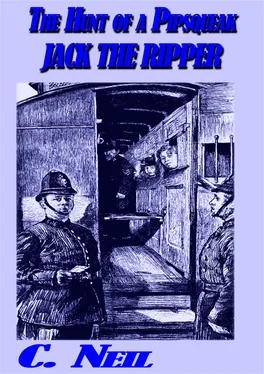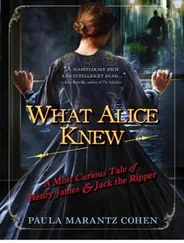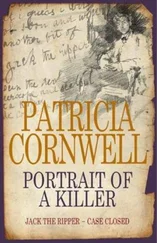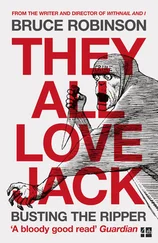C. Neil - The Hunt of a pipsqueak Jack the Ripper
Здесь есть возможность читать онлайн «C. Neil - The Hunt of a pipsqueak Jack the Ripper» — ознакомительный отрывок электронной книги совершенно бесплатно, а после прочтения отрывка купить полную версию. В некоторых случаях можно слушать аудио, скачать через торрент в формате fb2 и присутствует краткое содержание. Жанр: unrecognised, на немецком языке. Описание произведения, (предисловие) а так же отзывы посетителей доступны на портале библиотеки ЛибКат.
- Название:The Hunt of a pipsqueak Jack the Ripper
- Автор:
- Жанр:
- Год:неизвестен
- ISBN:нет данных
- Рейтинг книги:4 / 5. Голосов: 1
-
Избранное:Добавить в избранное
- Отзывы:
-
Ваша оценка:
- 80
- 1
- 2
- 3
- 4
- 5
The Hunt of a pipsqueak Jack the Ripper: краткое содержание, описание и аннотация
Предлагаем к чтению аннотацию, описание, краткое содержание или предисловие (зависит от того, что написал сам автор книги «The Hunt of a pipsqueak Jack the Ripper»). Если вы не нашли необходимую информацию о книге — напишите в комментариях, мы постараемся отыскать её.
The Hunt of a pipsqueak Jack the Ripper — читать онлайн ознакомительный отрывок
Ниже представлен текст книги, разбитый по страницам. Система сохранения места последней прочитанной страницы, позволяет с удобством читать онлайн бесплатно книгу «The Hunt of a pipsqueak Jack the Ripper», без необходимости каждый раз заново искать на чём Вы остановились. Поставьте закладку, и сможете в любой момент перейти на страницу, на которой закончили чтение.
Интервал:
Закладка:
C. Neil
The Hunt of a pipsqueak Jack the Ripper
Dieses ebook wurde erstellt bei

Inhaltsverzeichnis
Titel C. Neil The Hunt of a pipsqueak Jack the Ripper Dieses ebook wurde erstellt bei
Slumming
Martha Tabram a.k.a. Emma Turner
Inquest: Martha Tabram
A single cry of "MURDER!"
Mary Ann Nichols
Telegram from "Jack the Ripper."
Visiting the common Lodging house
Inquest: Annie Chapman
Elizabeth Stride
The grapes
Schwartz in the Star interview.
Inquest: Elizabeth Stride
Catherine Eddowes
Inquest: Catherine Eddowes
Mary Jane Kelly
Impressum neobooks
Slumming
Slumming (Soc., 1883). Visiting the poorest parts with a view to or slums of a self-improvement. The results of a little city experiment, which has been tried with the kindly consent of the Benchers of the Inner Temple, people is are well worth the attention of who interest themselves in what cynically August 1884. called 'slumming'.
The begin of London slums date back to the middle eighteenth century, when the masses of London, began to raise at an extraordinary rate. In the last decade of the nineteenth century London's population exploded to over four million, which spurred a high demand for low-priced living and housing. London slums are the result of quick population growth immigration and the industrialization. London slums became notorious for overfilling, unhygienic and the row living conditions. Most wealthy Victorians were grows up with the idea that poor people are unproductive, lazy and alcoholics the rich Victorian overlooked the inhuman slum life situation, and many, who knows about the slums in the richest city in the world, believed that the slums were the product of laziness, sin of the lower classes the pc poor class. The most disreputable slums were located in East London, which was called "darkest London," a unknown continent for the honest society. Slums or rookeries existed in all districts of London, St. Giles and Clerkenwell in central London, the Devil's Acre near Westminster Abbey, Jacob's Island famous in Oliver Twist Dickens masterpiece. Rookeries in Bermondsey, on the south bank of the Thames River, the Mint in Southwark, and Pottery Lane in Notting Hill. In the last decades of the Victorian period East London was inhabited mostly by the working classes, which consisted of native English population, Irish immigrants, and immigrants Eastern Europe, mostly poor Russian, Polish and German Jews, who found asylum in Whitechapel and the neighboring areas of St. George’s-in-the-East and Mile End. Whitechapel was and is the heart of the East End. By the end of the seventeenth century it was a wealthy district. Some of its areas began to go down in the mid eighteenth century, and in the second half of the nineteenth century they became notorious overcrowded and crime infected. There are more people than there is room, and numbers are in the workhouse because they cannot find a very poor room elsewhere. Nearly fifty per cent of the workers pay 1890 from one-fourth to one-half of their earnings for rent. The average rent in the larger part of the East End is growing from four to six shillings per week for one room. In one street in Stepney the increase in only two years has been from thirteen to eighteen shillings; in another street from eleven to sixteen shillings; and in another street, from eleven to fifteen shillings; while in Whitechapel, two-room houses that recently rented for ten shillings are now costing twenty-one shillings. East, west, north, and south in London the rents are going up and the Slum Landlord are be richer and richer.
But perhaps there is nothing in London so exasperating as the Lodging-house keeper... This being starves you, freezes you, cheats you, waits upon you, steals from you, lies to you, flatters you, and backbites you; reads your private papers, has keys for all your boxes and drawers, and a complete inventory of all your effects. She chooses from your handkerchiefs, smoothes her hair with your brushes, scents it with your perfumes, ‘makes herself beautiful’ at your toilet. She examines your boots, and finds a pair which you ‘will never miss’, for her James. She brushes your trousers, and takes care of any loose change. She waits at your table, counts the oranges, and thinks she will try one. When you ask for that pie, she has given it to the dog—’I thought you were done with it, Sir.’ . . . She eats your bread, drinks your beer, tastes your wine; and charges you a shilling for a pinch of salt.... You sleep on ‘hobbles’, and are blotched in a curious manner. You hint to the servant that you have seen something as well as felt; but ‘nothing of that sort was ever in my house’. At last, when you find it quite impossible to satisfy the ever-increasing rapacity, you ‘think you will leave’. You are very forcibly reminded that you are bound to ‘a month’s notice, Sir’.
Ah-Chin-Le, Some Observations Upon the Civilization of the Western Barbarians, 1876.
Wretched houses with broken windows patched with rags and paper; every room let out to a different family, and in many instances to two or even three – fruit and ‘sweet stuff’ manufacturers in the cellars, barbers and red-herring vendors in the front parlous, cobblers in the back; a bird-fancier in the first floor, three families on the second, starvation in the attics, Irishmen in the passage, a ‘musician’ in the front kitchen, a charwoman and five hungry children in the back one – filth everywhere – a gutter before the houses, and a drain behind – clothes drying, and slops emptying from the windows; ... men and women, in every variety of scanty and dirty apparel, lounging, scolding, drinking, smoking, squabbling, fighting, and swearing.
Charles Dickens, Sketches by Boz, 1839 on St Giles Rookery
Whitechapel part of the east end Street like the Dorset Street a breeding ground for criminals, prostitutes,) Whitechapel housed a community largely comprised of poor immigrant families, including many Jews fleeing persecution in Russia and Eastern Europe, most of whom were crammed into squalid tenements with 7-8 occupants per room. Most of the East End population was employed in factory work, with meager earnings and harsh conditions forcing many women into prostitution as a means of survival. The overpopulation of the urban districts, combined with horrific health conditions exacerbated by poor drainage and inadequate sanitation, created an environment in which diseases like typhoid fever and cholera, not to mention the venereal diseases spread by prostitution, claimed many lives and starvation and death were daily realities. The extreme poverty of the area also contributed to the rampant crime that plagued the East End. The scene of Whitechapel at the time of the murders was likely a grim picture of poverty’s worst elements; unlit alleys and drunken vagrants created dangerous conditions for the many prostitutes who walked the streets or worked out of brothels. were assign in the impoverished Whitechapel area in the East End of London between 3 April 1888 and 13 February 1891. At various points some or all of these eleven unclear murders of women have been ascribed to the notorious faceless serial killer known as Jack the Ripper. Most of the victims Martha Tabram, Mary Ann Nichols, Annie Chapman, Elizabeth Stride, Catherine Eddowes, Mary Jane Kelly, Rose Mylett, Alice McKenzie, Frances Coles, and two unidentified Torsos were poor prostitutes with a alcoholic problem. Tabram was stabbed 39 times. Nichols, Chapman, Stride, Eddowes, Kelly, McKenzie and Coles had their throats cut. Eddowes and Stride were killed on the same night, 45 minutes and 0,75 a mile apart; their murders were named the "double event", after a phrase in a postcard sent to the press by someone claim to be the Ripper. The bodies of Nichols, Chapman, Eddowes and Kelly had abdominal mutilations and the Clothes where disarranged. Rose Mylett was strangled. The body of the unidentified woman was dismembered, but the exact cause of her death is unclear. The Metropolitan Police, City of London Police, and private organizations such as the Whitechapel Vigilance Committee were involved in the search for the killer but sure killers. Despite extensive inquiries and several arrests, the culprit or culprits evaded identification and capture. The murders draw the public attention to the living conditions of the Poor Class in the London East End slums, which were subsequently improved.
Читать дальшеИнтервал:
Закладка:
Похожие книги на «The Hunt of a pipsqueak Jack the Ripper»
Представляем Вашему вниманию похожие книги на «The Hunt of a pipsqueak Jack the Ripper» списком для выбора. Мы отобрали схожую по названию и смыслу литературу в надежде предоставить читателям больше вариантов отыскать новые, интересные, ещё непрочитанные произведения.
Обсуждение, отзывы о книге «The Hunt of a pipsqueak Jack the Ripper» и просто собственные мнения читателей. Оставьте ваши комментарии, напишите, что Вы думаете о произведении, его смысле или главных героях. Укажите что конкретно понравилось, а что нет, и почему Вы так считаете.











